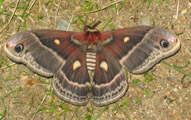Native Plants
Search for native plants by scientific name, common name or family. If you are not sure what you are looking for, try the Combination Search or our Recommended Species lists.
Rhododendron canadense
Rhododendron canadense (L.) Torr.
Rhodora
Ericaceae (Heath Family)
Synonym(s): Azalea canadensis, Rhodora canadensis
USDA Symbol: RHCA6
USDA Native Status: L48 (N), CAN (N), SPM (N)
Rhodora is a rather scrawny, erect-branched deciduous shrub that seldom grows over 3-4 ft. tall. Oval leaves are hairy underneath and distinctly gray-green. The principal beauty lies in the showy clusters of rose-purple flowers occuring in terminal clusters. The flowers are different from other member of the genus; the 3 upper lobes are almost united to the end and erect, the 2 lower lobes are oblong, divided and spreading.
This small northern shrub has very showy flowers that open before or with its leaves.
Plant Characteristics
Duration: PerennialHabit: Shrub
Leaf Retention: Deciduous
Leaf Arrangement: Alternate
Leaf Complexity: Simple
Breeding System: Flowers Bisexual
Fruit Type: Capsule
Size Notes: Up to about 4 feet tall.
Leaf: Dark Green
Bloom Information
Bloom Color: White , Pink , PurpleBloom Time: Mar , Apr , May
Bloom Notes: Rose-purple to pink, rarely white.
Distribution
USA: CT , MA , ME , NH , NJ , NY , PA , RI , VTCanada: NB , NL , NS , ON , PE , QC
Native Distribution: Nf. to e. Ont., s. to e. PA & n. NJ
Native Habitat: Swamps; moist, high altitude woods
Growing Conditions
Water Use: HighLight Requirement: Sun , Part Shade
Soil Moisture: Dry , Moist , Wet
Soil pH: Acidic (pH<6.8)
CaCO3 Tolerance: None
Soil Description: Cold, wet, acid or peaty soil.
Conditions Comments: Requires a cool climate. Good cultural practices reduce the incidence of disease and insect damage.
Benefit
Use Wildlife: BeesUse Food: done not eat
Warning: Rhododendrons contain poisonous substances and should not be ingested by humans or animals. Honey made from flowers also may be toxic. POISONOUS PARTS: All parts. Highly Toxic, May be Fatal if eaten. Symptoms include salivation, watering of eyes and nose, abdominal pain, loss of energy, depression, nausea and vomiting, diarrhea, weakness, difficult breathing, progressive paralysis of arms and legs, coma. Toxic Principle: Andromedotoxin. (Poisonous Plants of N.C.)
Conspicuous Flowers: yes
Attracts: Butterflies
Larval Host: Columbia silkmoth
Value to Beneficial Insects
Special Value to Bumble BeesThis information was provided by the Pollinator Program at The Xerces Society for Invertebrate Conservation.
Butterflies and Moths of North America (BAMONA)
|
Columbia silkmoth (Hyalophora columbia)  Larval Host |
Propagation
Description: Sow tiny seeds on peat under mist or a plastic tent.Seed Treatment: No pretreatment is necessary.
Commercially Avail: yes
National Wetland Indicator Status
| Region: | AGCP | AK | AW | CB | EMP | GP | HI | MW | NCNE | WMVE |
| Status: | FACW | FACW | FACW |
From the National Organizations Directory
According to the species list provided by Affiliate Organizations, this plant is on display at the following locations:Delaware Nature Society - Hockessin, DE
Bibliography
Bibref 1186 - Field Guide to Moths of Eastern North America (2005) Covell, C.V., Jr.Bibref 1185 - Field Guide to Western Butterflies (Peterson Field Guides) (1999) Opler, P.A. and A.B. Wright
Search More Titles in Bibliography
Web Reference
Webref 38 - Flora of North America (2019) Missouri Botanical Garden, St. Louis, MO & Harvard University Herbaria, Cambridge, MA.Webref 23 - Southwest Environmental Information Network (2009) SEINet - Arizona Chapter
Additional resources
USDA: Find Rhododendron canadense in USDA PlantsFNA: Find Rhododendron canadense in the Flora of North America (if available)
Google: Search Google for Rhododendron canadense
Metadata
Record Modified: 2023-02-24Research By: TWC Staff